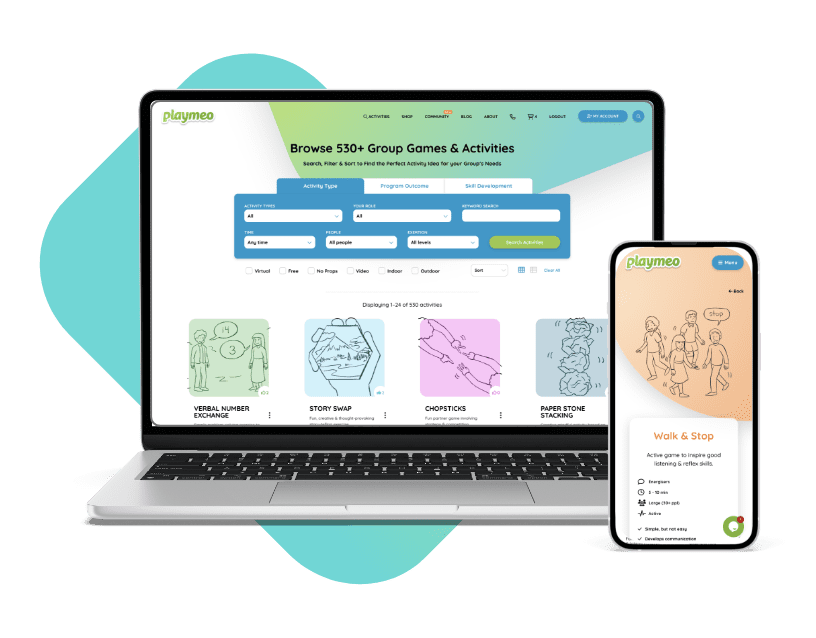Download our free 28-page ebook jam-packed with outrageously fun activity ideas.
How To Break Up Cliques
This week’s Facilitator Tips episode shares a bunch of simple, yet practical strategies you can use to break up cliques of small groups that resist any invitation to mix with people they do not know.
<< Go to Episode 33 Go to Episode 35 >>
Humans are comfort-seeking machines, so it makes sense that we are inclined to form small groups with people we like or are like.
But, if left unmanaged, cliques can be very damaging to a program that would benefit from the interactions of people who are more comfortable with each other.
Click the play button above to learn more about how to break up cliques.
Want to join the conversation?
Please leave a comment at the bottom of the page (you must be logged in.)
Don’t have a playmeo account? Join today.
Useful Links & Resources
- Getting Into Pairs – prevention is often better than the cure, so here are dozens of fun and random ways to invite individuals to form into groups of two people.
- Getting Into Teams – ditto, if you’re wondering how to break up cliques, there are dozens of really simple and engaging ways to break your large group into smaller random groupings.
- Episode 2 – this episode of the Facilitator Tips video series is focused entirely on creating random, mixed teams to help you prevent cliques from forming.
…EE
Video Transcript
Hi there and welcome to Episode 34 of the Facilitator Tips video series.
My name is Mark Collard. I work as an author and I’m also an experiential trainer. And in this series, I want to share with you a ton of stuff that I’ve learned that really helps me more effectively facilitate my groups.
And this is a really big one: How do I break up cliques? Now there might be different terms that you use to describe this impact, but it’s those times when two or more people gather together and don’t really let anyone into their little clique or indeed find it very difficult to interact with others.
Now there’s not necessarily anything wrong with that. As human beings, as comfort-seeking machines, it is really important that we acknowledge that that’s a default position for us. But if you are in the world of wanting to strengthen and build relationships, this is going to be a massive barrier for you because people aren’t willing to step outside there.
So here’s a series of I guess frameworks and strategies that I have found that help me break those cliques. First of all, you need to be really intentional about this. As I’ve mentioned in other episodes, the most successful programs are those which intentionally build trusting and healthy relationships.
And then the next part is ‘from the start’. That doesn’t mean if you’re halfway through your semester or your training program or camp that you can’t start this, but it’s certainly more effective if you can do it right from the beginning. So that’s the first tip.
The second part is, use a series of random techniques. If you check out Episodes 1 and 2, the first in our series of this video tutorial series, you’ll see dozens of ways of creating random pairs and random teams, groups of three or more people. They’re fun, they’re engaging, they’re different, and they invite people to mix up that maybe at first glance they wouldn’t have done.
And they have been really successful because they have been engaging, they have been fun, and importantly, randomly distribute people which is a great way to break up some of those cliques.
And then finally, use an agreement. If you have long periods of time with your group, things like the Full Value Contract can be a really powerful way, a working agreement to actually right from the beginning actually create a sense of who you’re going to be and how you’re going to interact with each other. And if one of those key parts is about interacting with others and building those relationships, then that agreement at the beginning can be a really powerful way to invite those naturally-forming cliques to maybe step outside of their comfort zone.
There’s a great deal more to share in this space and you’ll find more details in many of our other episodes. But hopefully, if nothing else, check out Episodes 1 and 2 if you’ve not already or have only just come across this in your search online.
My name is Mark Collard. It’s been my pleasure to always present to you really useful, practical information. If you’ve got something to share, please leave a comment. Otherwise, feel free to share this with some of your colleagues.
Until next time, I look forward to seeing you. Bye-bye.







There are currently no comments